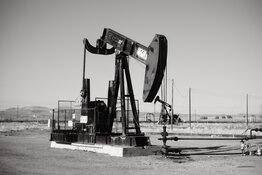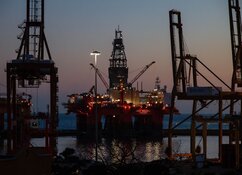Marin Katusa: Though Syria is not a major producer of oil, the impact of war can reach far beyond its borders. Conflict in the Middle East almost always results in higher oil prices for the rest of the world.
TER: Matt Badiali, editor of the S&A Resource Report, has said that Libya's collapse could have a material impact on oil prices because it is a large oil producer. Do prices go up more based on actual supply disruptions or investors reacting to headlines?
MK: Prices go up for both reasons. Matt is a smart guy and a friend, and he is right about Libya. Prices are based on both actual supply and psychological factors. War results in a speculation premium, but the reality is that conflict is never good for oil production. Therefore, less production occurs, which results in higher oil prices.
TER: You recently published a primer on the history between Iran and Iraq, based on Shiite rule in both countries. How do those shifts impact oil prices in Europe and the U.S.?
MK: It impacts Europe more than the U.S. Even though the Shiites are a minority in the Middle East, there is a significant risk of a spillover effect in the Middle East, in areas like eastern Saudi Arabia. The Europeans, unfortunately, depend more on Middle Eastern oil than North America, which has developed its own natural resources. Europeans, as a result, pay more than twice as much for gas, and up to three times as much for electricity. What's the European backup plan? Russian oil and natural gas.
In the U.S., oil and gas companies have been successful in exploiting unconventional resources, and with the success of the heavy oil from Canada, the U.S. refineries are not as dependent on oil from the Middle East compared to the Europeans.
TER: Does that mean that there are going to be more opportunities in non-Middle East oil?
MK: There will be more opportunities for U.S. oil in fields that aren't developed yet, but the North American producers are not cheap anymore. To have a big score, investors in the resource sector want to target areas that are undeveloped. The big gains are in developing these massive resources. North America is not the only place with shale oil and gas. The key is taking positions in companies that are going to experience the large growth and development of these shale fields before consolidation by bigger companies.
TER: What about unconventional shale oil exploration? You've mentioned your early entry in 2007 into the shale gas sector with Cuadrilla Resources Ltd., an exploration and production company in the U.K. Is it too late to get involved in big opportunities like that?
MK: No, it's the opposite. Cuadrilla was one of the first companies to complete a shale gas well in the U.K. Cuadrilla is a perfect example of a company that no one had heard about when we recommended it. Today, the company is trading 25x north of when we first recommended it. That success is just scratching the surface of the potential of Europe. Europe is about 10–15 years behind North America on shale development, and yet its shale formations look more promising than some of the shale formations in North America. The geology is promising, the infrastructure is already there, there is plenty of local demand and premium pricing—there are still a lot of opportunities in Europe.
TER: There have been issues with shale oil: decline rates, bottlenecked oversupplies and write-downs. How do you hedge against those sorts of risks?
MK: Bottlenecks and declines matter a lot for producers. The companies with the biggest gains from the Bakken, Marcellus shale and Eagle Ford got in early because they had an idea and proved up the concept. Those companies got bought out by bigger companies. By the time there are infrastructure bottlenecks due to production, a project has turned into a multi-well program with hundreds of wells drilled. That's a big company problem.
That's an issue in the Bakken because it's been so successful. There is not enough pipeline to move the oil to the refineries, so they've been moving it with rail oil tankers. The industry is very entrepreneurial, and it's solved its own problems.
Before the bottleneck issues, you have to prove up the concept and then you're going to get the major companies that want exposure to these world-class shale formations. Cuadrilla is a case study of what is going to start happening in Europe with shale exploration.
TER: Each shale is different. The geology is different. The type of gas or oil coming out is different. How easily the product can be transported makes a difference in the price. What's the most important of those factors?
MK: Most important for an investor is to differentiate between gas shales and oil shales. Then determine the costs to drill. Let's take for example, the most recent results from the Chinese shale wells, which were not as promising as the Chinese hoped. They are gas shales north of 7,000 meters (7,000 m) deep. They also contain sour gas. These wells cost north of $15 million ($15M) to drill, complete and frack, and China lacks the infrastructure that the U.S. benefited from. Investors need to understand the end product. Is it dry gas? It is liquid rich? Are you in the oil formation? Are you in the vapor zone? No two shales are the same. Even in the U.S., some are naturally severely fractured, some are deep, some are oil rich and others are dry-gas rich.
You have to understand what you are investing in, what type of commodity you're looking for, the costs and how that company is going to fund itself, because shale exploration is expensive exploration. Investors should be cautious of companies promoting moose pasture as resource-rich shale. Investors beware—homework required.
The European economy will not be able to get its act together and be competitive with Asia and North America until it lowers its energy costs. When you're paying two to three times more for electricity and three to four times more for natural gas than your U.S. competitors, your ability to compete on a global stage is extremely compromised. Certain parts of Europe have excellent infrastructure—stay away from other parts where there is no infrastructure. Oil wells were drilled in Europe and producing before wells were drilled and producing in North America. The key is applying modern technologies that have worked in North America to old, but proven, fields that have never experienced any modern technology.
TER: Do those resources have to compete with Russia?
MK: These resources will become an alternative to Russian energy sources. Many European countries are more dependent on Russian fuel sources today than they were 20 years ago. The U.K.'s North Sea production is not what it used to be because of declining production and an increased government tax rate.
I find it ironic that European protestors are against the development of their own natural resources, yet at the same time are trying to protest Vladimir Putin's energy agendas. Europe's lack of developed resources is exactly what keeps the continent dependent on Russian natural resources.
TER: What about North America? Are you as optimistic about the opportunities there?
MK: Definitely. Mexico has become a major importer of U.S. natural gas. Petróleos Mexicanos (PEMEX), the national oil company in Mexico, has seen a significant decrease in production because it has spent its profits funding social programs rather than reinvesting them into the oil and gas fields. Now it needs to import from the U.S. In the next five years, Mexico could open up to foreign companies. It's going to be something we're watching very closely. It's definitely something investors will want to keep on their radar as the Eagle Ford extends into Mexico.
In North America, and Canada specifically, a hot story is companies profiting from West Coast liquefied natural gas (LNG). The oil sands are a very exciting story, as is further development of the shale fields in North America. But you're not going to get the big upside in North America because developing and producing these shale formations after they've been discovered is no longer in the cards for a small company. It's just too capital intensive. The biggest upside for a small company is getting the real estate before anyone else recognizes it and attracting the majors' large pocketbooks to develop those fields. Junior companies can't develop oil sands. It's too expensive. LNG is a big-company game. And you're not going to get a 10 bagger with these big oil companies.
TER: What about oil services?
MK: It's the same story. We've had a great run recently with Halliburton Co. (HAL:NYSE), Trican Well Service Ltd. (TCW:TSX) and Calfrac Well Services Ltd. (CFW:TSX). They will benefit from the development of these North American shale fields. We were surprised how well Halliburton did because it's the world's second-largest service company, but you're not going to get the multibagger potential out of these companies. They will pay decent yields, nothing extravagant.
TER: You and Rick Rule have talked a lot about the inevitability of a uranium renaissance, but prices have actually come down since the beginning of the year. In May, you moderated a webinar that pointed to increased demand and decreased supply due to a shift in leadership in Japan on the demand side and the end of the Russian program pumping converted nuclear fuel into the market on the supply side. Are you still predicting price increases for uranium?
MK: I'm very bullish. Since our webinar, of the Top 3 companies that we presented, one is up 65% in this market and another had a 100% gain. That said, we are starting to see more companies announce lower production and delayed production due to the low prices of uranium. The cure for low prices is low prices, and we are starting to see that.
There is still hesitation in the market because of the tragedy at Fukushima and radiation that continues to leak into the water. Japan has had to slow down bringing nuclear reactors back online.
What has really changed long term? Nothing. The trends driving the market are still in place. Growth in China will continue. Investors should be invested in either the highest-grade deposits, which are in the Athabasca Basin in Canada, or the lowest-cost producers, such as the ones that have in situ recovery (ISR) production in the U.S.
If you focus on ISR in the U.S., you want to be exposed to warmer ISR production. It's about 25–30% cheaper to produce with this method because they don't need to insulate the wells. Whenever you're moving water, you don't want to be around cold temperatures because freezing occurs.
Stay away from companies that have large debt loads they incurred before Fukushima; that is crippling to a company. The low-grade, conventional producers, such as Paladin Energy Ltd. (PDN:TSX; PDN:ASX), are suffering from low spot uranium prices and debt. We've always stayed away from companies like that. Uranium Energy Corp. (UEC:NYSE.MKT) has actually increased in price since our webinar because it is a low-cost, shallow ISR producer that aligned itself with the price of the commodity. If uranium goes up, it can produce more uranium from its ISR wells, but if the price goes down, it is not depleting its reserves by producing at a low price.
With conventional uranium production, the fixed costs of running the mine are much higher. They can't just shut down like an ISR operation, which is more like an oil or gas well where you can increase and decrease the production.
At the same time, the U.S. Energy Information Administration (EIA) recently came out with a report showing that the long-term dependency on uranium for North America is still there. With Asia developing its diversified energy matrix, countries like Korea, China and even Japan will have uranium demand. Japan's electricity costs are crippling its economy. It is paying north of $16/thousand cubic feet ($16/Mcf) where in Canada they're paying less than $3/Mcf. Even with all the horrible news coming out in the aftermath of the Fukushima disaster, Japan will bring on its nuclear reactors—not on the timeframe uranium investors would like, but it will happen.
TER: Do you focus on the spot price or the long-term price?
MK: I focus more on the long-term price because more than 90% of the uranium traded globally is based on the long-term price. The spot price, which everybody is so worried about, makes up between 5–8% of the uranium traded. That's irrelevant. Even in a decreasing uranium market, you're looking at prices north of 40% higher for the long-term price—very bullish for uranium long term.
It's funny because the oil markets are currently in backwardation, meaning that future oil prices are lower than current prices, and the opposite is true for uranium, yet the investors are avoiding the uranium sector like the plague. They will eventually come back, and at that time, you will want to sell your stocks. Uranium is a perfect contrarian investment right now.
TER: You mentioned Uranium Energy Corp. Are there any catalysts for that company coming up?
MK: President Amir Adnani has positioned Uranium Energy to maintain its strong balance sheet in this near-term tough market by decreasing the production at its Palangana mine, while advancing Goliad toward production this fiscal year and advancing the large Burke Hollow ISR project towards production. The company trades at a discount to its net asset value (NAV), and Uranium Energy is positioning itself well for when uranium prices do recover. Over the years, I've watched Uranium Energy go from exploration to production. Palangana was proof that the hub-and-spoke strategy works. Once Goliad comes on-line, the big cash flows will start for the company. Uranium Energy is a low-cost producer. One in 3,000 exploration projects ever becomes a mine, so the company has already beat that hurdle. More important for me is that Uranium Energy is doing all this while preserving a strong balance sheet. Other companies have not positioned themselves to be able to keep a strong balance sheet. I'd expect Uranium Energy will probably do some major acquisitions within the next 12 months.
The president of the company, Amir Adnani, who is on the Casey NexTen List, has positioned the company to benefit from a weak market. That's the type of company that we want to be invested in—strong balance sheet, strong management team and always looking to grow the company. When the spot price does catch up to the long-term price and the long-term price increases because of the growing demand, Uranium Energy will be able to increase production because it has already developed its assets.
I believe that within 10 years, just like the oil market has a WTI and Brent pricing, there will be a divergence in the uranium price between the east and the west. No one has ever talked about this.
With the highly enriched uranium (HEU) agreement ending at the end of this year, there is going to be a transition agreement, which everyone knows is already going to cost more for the Americans than the HEU agreement. When the Asians, Saudi Arabia and the Middle East do develop reactors, the Russians will start signing deals with them and there will be a divergence. The U.S. producers of uranium will get a premium because it's a safe, local, domestic, strategic supply of fuel.
In the early 1960s, the U.S. produced more than 30 million pounds (30Mlb). It was the No. 1 producer of uranium in the world. Last year, it produced less than 3.5 Mlb. Yet, it has increased its consumption of uranium during that time. Here's a real ironic result of the cold war: American producers produce less uranium on American soil than Russians produce on American soil. The Russians bought a company called Uranium One, which produces more uranium in the U.S. than all U.S. uranium producers combined. Eventually the market will catch up to itself, and you want to be positioned with U.S., low-cost producers that are able to adjust their production to optimize their cash flows depending on the spot price and the long-term price of uranium.
In two to five years, there should be significantly higher uranium prices. Remember when Doug Casey and Rick Rule first started talking heavily about uranium in 1998? The uranium bull market didn't start until about 2004. Things always take longer than people want them to, but they can go a lot higher than you can expect, too. Investors want to be positioned with the right companies that will survive this downturn.
TER: What other uranium company do you like?
MK: Uranium Participation Corp. (U:TSX). It's actually the lowest-risk way to invest in uranium. It has no production risk. It has no exploration risk. It has no management risk. It has no political or environmental risks. Uranium Participation Corp. (U:TSX) is essentially a holding company for U3O8 uranium and UF6 uranium hexafluoride. It's probably the only way retail investors can have exposure to UF6, which I'm also very bullish on. The company's NAV is split pretty evenly between U3O8 and UF6. It has the uranium in a storage warehouse that's insured and bonded. We've had a lot of e-mails come in that say, "Well, what happens if someone comes in and steals the uranium?" That would actually be an ideal situation because then the insurance companies would have to replace the stolen uranium, and because the company trades at a discount to its NAV, investors would get a boost from that unrealistic event.
TER: You're going to be speaking, along with Ron Paul and Doug Casey, at the Casey Research 2013 Summit in October in Arizona. What's the message you're going to be sharing there?
MK: I've put together an energy panel with the former energy secretary of the U.S., the former energy minister of Canada, the U.K. authority on nuclear energy and the Middle East, Keith Hill with Africa Oil Corp (AOI:TSX.V) and Nolan Watson from Sandstorm Metals and Energy Ltd. (SND:TSX.V). The panel, which I'll be moderating with these industry heavyweights, is going to be focused on oil, natural gas, uranium and coal.
TER: Do you have any final advice for how in the midst of possible war in multiple hotspots, energy investors can position themselves defensively, or be optimized for what could be coming?
MK: I think investors have to focus on the political risks. This will sound horrible from a moral standpoint, but conflict in the Middle East will be good for investors exposed to oil if they understand the political risks. If we have more conflicts in the Middle East, there is one sure result: higher oil prices. That is good for the energy investor. To position yourself best, you want to invest in companies that have a strong management team, a strong balance sheet and that are in areas that are most affected by the conflicts and higher oil prices. Do you want to be invested in a company producing oil in Egypt with all this conflict potential? No, you don't. Do you want to be invested in a company that is exploring for oil in Europe? I have, and I think you should too.
TER: Thank you very much for taking the time to talk to us.
MK: My pleasure.
With a background in mathematics, Marin Katusa left teaching post-secondary mathematics to pursue portfolio management within the resource sector. He is regularly interviewed on national and local television channels in North America such as the Business News Network (BNN) and many other radio and newspaper outlets for his opinions and insights regarding the resource sector. Katusa is the chief investment strategist for the energy division of Casey Research. He is the editor of the Casey Energy Report, Casey Energy Confidential and Casey Energy Dividends newsletters. A regular part of his due diligence process for Casey Research includes property tours, which has resulted in him visiting hundreds of mining and energy producing and exploration projects all around the world. For more information about the Casey Research 2013 Summit, October 4, 5 and 6 in Tucson, Arizona, visit the Casey Research 2013 Summit.
Want to read more Energy Report interviews like this? Sign up for our free e-newsletter, and you'll learn when new articles have been published. To see a list of recent interviews with industry analysts and commentators, visit our Interviews page.
DISCLOSURE:
1) JT Long conducted this interview for The Energy Report and provides services to The Energy Report as an employee. She or her family owns shares of the following companies mentioned in this interview: None.
2) The following companies mentioned in the interview are sponsors of The Energy Report: None. Streetwise Reports does not accept stock in exchange for its services or as sponsorship payment.
3) Marin Katusa: I or my family own shares of the following companies mentioned in this interview: Uranium Participation Corp and Uranium Energy Corp. I personally am or my family is paid by the following companies mentioned in this interview: None. My company has a financial relationship with the following companies mentioned in this interview: None. I was not paid by Streetwise Reports for participating in this interview. Comments and opinions expressed are my own comments and opinions. I had the opportunity to review the interview for accuracy as of the date of the interview and am responsible for the content of the interview.
4) Interviews are edited for clarity. Streetwise Reports does not make editorial comments or change experts' statements without their consent.
5) The interview does not constitute investment advice. Each reader is encouraged to consult with his or her individual financial professional and any action a reader takes as a result of information presented here is his or her own responsibility. By opening this page, each reader accepts and agrees to Streetwise Reports' terms of use and full legal disclaimer.
6) From time to time, Streetwise Reports LLC and its directors, officers, employees or members of their families, as well as persons interviewed for articles and interviews on the site, may have a long or short position in securities mentioned and may make purchases and/or sales of those securities in the open market or otherwise.








































